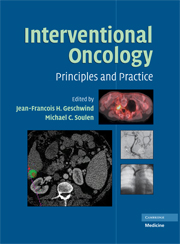Book contents
- Frontmatter
- Contents
- FOREWORD
- ACKNOWLEDGMENTS
- CONTRIBUTORS
- PART I PRINCIPLES OF ONCOLOGY
- PART II PRINCIPLES OF IMAGE-GUIDED THERAPIES
- PART III ORGAN-SPECIFIC CANCERS
- PART IV SPECIALIZED INTERVENTIONAL TECHNIQUES IN CANCER CARE
- 42 Vascular Access: Venous and Arterial Ports
- 43 Gastrointestinal Stenting
- 44 Diagnosis and Management of Superior Vena Cava Syndrome
- 45 Palliative Care and Symptom Management
- 46 Complications of Therapeutic Endovascular Procedures in Malignant Liver Diseases
- INDEX
- Plate section
- References
45 - Palliative Care and Symptom Management
from PART IV - SPECIALIZED INTERVENTIONAL TECHNIQUES IN CANCER CARE
Published online by Cambridge University Press: 18 May 2010
- Frontmatter
- Contents
- FOREWORD
- ACKNOWLEDGMENTS
- CONTRIBUTORS
- PART I PRINCIPLES OF ONCOLOGY
- PART II PRINCIPLES OF IMAGE-GUIDED THERAPIES
- PART III ORGAN-SPECIFIC CANCERS
- PART IV SPECIALIZED INTERVENTIONAL TECHNIQUES IN CANCER CARE
- 42 Vascular Access: Venous and Arterial Ports
- 43 Gastrointestinal Stenting
- 44 Diagnosis and Management of Superior Vena Cava Syndrome
- 45 Palliative Care and Symptom Management
- 46 Complications of Therapeutic Endovascular Procedures in Malignant Liver Diseases
- INDEX
- Plate section
- References
Summary
PALLIATIVE CARE AND COMMUNICATION WITH CANCER PATIENTS
Overview of Palliative Care
The World Health Organization defines palliative care as care [T]hat improves the quality of life of patients and their families facing the problems associated with life-threatening illness, through the prevention and relief of suffering by means of early identification and impeccable assessment and treatment of pain and other problems, physical, psychosocial and spiritual (1). Medical care is focused on symptom relief and maximizing patient function, without necessarily impacting the natural history of the underlying illness. The unit of care is defined as the patients, along with their loved ones, and bereavement support is integral to its mission. Palliative care is interdisciplinary, involving not only nurses and physicians but also chaplains, psychologists, social workers, and speech, physical, occupational and other therapists. Although palliative care has historic roots in the terminal care of dying cancer patients, its scope encompasses a wide variety of patients with non-malignant diseases. These include dementia and other neurodegenerative disorders; advanced organ disease such as lung, heart, liver and kidney failure; and critically ill patients in medical, neurological, surgical and trauma critical care units (2, 3). Ideally, palliative care is provided to patients with severe illnesses early in the course of their disease, alongside disease-modifying or curative therapy. As an illness progresses, and as disease-modifying or even life-prolonging interventions become less available, a patient's entire care may become palliative focused.
- Type
- Chapter
- Information
- Interventional OncologyPrinciples and Practice, pp. 563 - 588Publisher: Cambridge University PressPrint publication year: 2008



